
Field Marshal and Count Jacob Pontusson De la Gardie was a statesman and a soldier of the Swedish Empire, and a Marshal from 1620 onward.
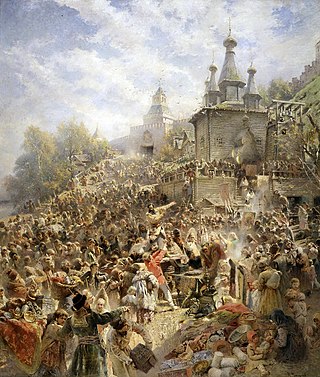
The Time of Troubles, or Smuta, was a period of political crisis in the Tsardom of Russia which began in 1598 with the death of Feodor I, the last of the Rurik dynasty, and ended in 1613 with the accession of Michael I of the House of Romanov.

Dmitry Mikhaylovich Pozharsky was a Russian prince known for his military leadership during the Polish–Muscovite War from 1611 to 1612. Pozharsky formed the Second Volunteer Army with Kuzma Minin in Nizhny Novgorod against the Polish–Lithuanian Commonwealth's occupation of Russia during the Time of Troubles, resulting in Polish withdrawal after Russian victory at the Battle of Moscow in 1612. Pozharsky received the unprecedented title of Saviour of the Fatherland from Mikhail I of Russia, becoming a folk hero in Russian culture and honored in the Monument to Minin and Pozharsky in Moscow's Red Square.
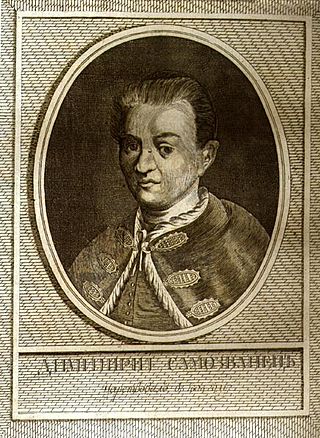
False Dmitry I reigned as the Tsar of all Russia from 10 June 1605 until his death on 17 May 1606 under the name of Dmitriy Ivanovich. According to historian Chester S.L. Dunning, Dmitry was "the only Tsar ever raised to the throne by means of a military campaign and popular uprisings".

Vasili IV Ivanovich Shuisky was Tsar of all Russia from 1606 to 1610, after the murder of False Dmitri I. His rule coincided with the Time of Troubles. He was the only member of House of Shuisky to become tsar and the last member of the Rurikid dynasty to rule as tsar.
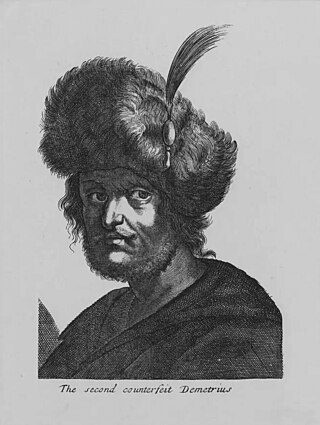
False Dmitry II, historically known as Pseudo-Demetrius II and also called tushinsky vor, was the second of three pretenders to the Russian throne who claimed to be Tsarevich Dmitry Ivanovich, the youngest son of Ivan the Terrible, during the Time of Troubles. The real Dmitry had died under uncertain circumstances, most likely an assassination in 1591 at the age of nine at his widowed mother's appanage residence in Uglich.

The Polish–Muscovite War of 1605–1618, also known as the Polish–Muscovite War or the Dimitriads, was a conflict fought between the Tsardom of Russia and the Polish–Lithuanian Commonwealth together with Zaporozhian Cossacks from 1605 to 1618.
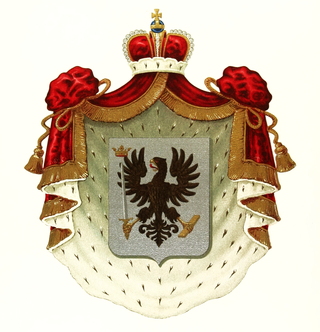
Prokopy Petrovich Lyapunov was a prominent 17th century Russian nobleman (dvoryanin), voivode of, allegedly, a Rurikid origin who practically became a head of Pereyaslavl-Ryazansky lands nobility in the end of 1590s; he took part in wars during power vacuum in succession crisis that happened in early 1598 in Tsardom as result of confusion about legitimate heir apparent following death of Feodor I, nobility infighting, war declared by Polish–Lithuanian Commonwealth (PLC) in 1605, and exhaustive Tatar raids; most famously he is remembered for organizing and leading the first unsuccessful uprising against occupation of Moscow of 1610 by PLC in April of 1611.

Prince Mikhail Vasiliyevich Skopin-Shuisky was a Russian statesman and military figure during the Time of Troubles. He was the last representative of a cadet branch of the Shuysky family.

The De la Gardie campaign was a joint military campaign by the Tsardom of Russia and Sweden during the Polish–Muscovite War from April 1609 to June 1610.

Ivan Isayevich Bolotnikov headed a popular uprising in Russia in 1606–1607 known as the Bolotnikov Rebellion. The uprising formed part of the Time of Troubles in Russia.

Prince Dmitry Timofeyevich Troubetzkoy was a Russian military and political figure during the Time of Troubles, one of the leaders in a rebellion against the Polish occupation and the leader of the Zemsky Sobor's provisional government.

Aleksander Józef Lisowski HNG was a Polish–Lithuanian noble (szlachcic), commander of a mercenary group that after his death adopted the name "Lisowczycy." His coat of arms was Jeż (Hedgehog).

The Tula Kremlin is a fortress in Tula, Russia, which was constructed in the early 16th century.

The Battle of Moscow was a series of two battles, which took place in Moscow, on September 1 and 3, 1612, during the Polish–Muscovite War (1605–18), and Time of Troubles. Forces of the Polish–Lithuanian Commonwealth were commanded by Field Hetman of Lithuania, Jan Karol Chodkiewicz, while the Russians were led by Dmitry Pozharsky. The battles ended in tactical Russian victories.

The siege of Kromy was the last major clash of government troops of Boris Godunov with the rebel army of False Dmitry I.
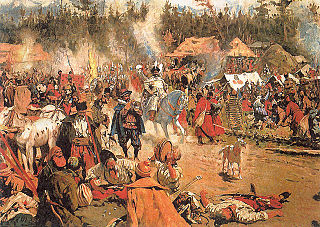
In the Battle of Bolkhov on May 10–11, 1608, the troops of False Dmitry II managed to defeat the army of Tsar Vasily Shuisky.
The Story of the Victories of the Moscow State, also known as The Tale of the Victories of the Moscow State, is a Russian literary work of the 17th century, a historical tale of the events of the Time of Troubles, mainly about the campaigns of the Smolensk noble militia and the struggle of the Smolensk nobles with Poles and supporters of False Dmitry.

The Uprising of Bolotnikov, in Russian historiography called the Peasant War under the Leadership of Ivan Bolotnikov (Peasant Uprising), was a major peasant, Cossack, and noble uprising of 1606–1607 led by Ivan Bolotnikov and several other leaders. At the time of the highest point of the uprising (the Siege of Moscow in 1606), more than 70 cities in the south and center of Russia were under the control of the rebels.

Wigund-Jeronym Trubecki or Yuri Nikitich Trubetsky as he was called earlier in Muscovy was the Prince of Trubetsk from 1611 to 1634, preceded by Symeon Iwanowicz Perski Trubecki, succeeded by Piotr Trubecki, and Aleksander Trubecki. Yuri Nikitich Trubetsky was also a boyar and equestrian of False Dmitry II. After emigrating to Poland, and restoring The Principality of Trubetsk, he converted to Catholicism, and took the name Wigund-Jeronym Trubecki.


















